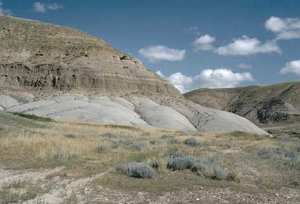|
 Located in the southeastern corner of the province and comprising 14 percent, or approximately 30 million acres, of Alberta's total natural landscape is a region referred to as the
Grasslands. Located in the southeastern corner of the province and comprising 14 percent, or approximately 30 million acres, of Alberta's total natural landscape is a region referred to as the
Grasslands.
Alberta's grasslands are part of the
Great Plains that stretch from the Gulf of Mexico, through the United States and into
Canada's prairie
provinces.
The Grassland Natural Region occupies a broad area of southern Alberta and extends west to the
Rocky Mountains and north to the southern edge of the
Parkland Natural Region in central Alberta. The region is a flat to gently rolling plain with a few major hill systems. Most of the
bedrock is covered with extensive, thick glacial till deposits. The diversity of the uplands is increased by numerous areas of fine-textured materials laid down in proglacial lakes and coarse-textured deposits in dune fields and outwash plains, both of which are associated with proglacial lake basins. with a few major hill systems. Most of the
bedrock is covered with extensive, thick glacial till deposits. The diversity of the uplands is increased by numerous areas of fine-textured materials laid down in proglacial lakes and coarse-textured deposits in dune fields and outwash plains, both of which are associated with proglacial lake basins.
|
|

Check out the Provincial
Museum of Alberta Habitat Gallery Audio!

The free downloadable
RealPlayer plugin from RealNetworks
is required to listen to the audio.

All kids and fun-loving adults will want to check out the Flash Zone to interact with species of the
Grassland Natural Region, including the Black
Widow and Ord's Kangaroo Rat!.

The free downloadable
Flash Player plugin from Macromedia
may be required.

|
|
 Rivers in the Grassland Natural Region are part of either the Saskatchewan River or Missouri River systems. Where valleys are carved deeply into bedrock, badlands have
developed, notably along the Red Deer River Valley. Numerous
coulees and ravines are associated with these river valley systems. Seven exposures of
igneous rock, all within the Milk River drainage, are the only igneous exposures in the grasslands of western Canada. With the exception of these isolated igneous outcrops, bedrock exposures are all of
sedimentary rocks and commonly occur along stream valleys. Rivers in the Grassland Natural Region are part of either the Saskatchewan River or Missouri River systems. Where valleys are carved deeply into bedrock, badlands have
developed, notably along the Red Deer River Valley. Numerous
coulees and ravines are associated with these river valley systems. Seven exposures of
igneous rock, all within the Milk River drainage, are the only igneous exposures in the grasslands of western Canada. With the exception of these isolated igneous outcrops, bedrock exposures are all of
sedimentary rocks and commonly occur along stream valleys.
There are four Subregions within the Grassland Natural Region: Dry
Mixedgrass, Mixedgrass, Northern
Fescue, and
Foothills Fescue. These Subregions are separated primarily by
different climates, soils and vegetation. The Dry Mixedgrass Subregion is most extensive,
starting at the United States border north and west to the Mixedgrass and Northern Fescue
Subregions. The Mixedgrass Subregion occurs generally west of the Dry Mixedgrass
Subregions. The Northern Fescue and Foothills Fescue Subregions occur in narrow belts along the northern and western margins of the Dry Mixedgrass and Mixedgrass
Subregions. Although not shown on the Natural Regions Map, there is a disjunct occurrence of Foothills Fescue in the Cypress Hills at higher elevations within the mapped Mixedgrass Subregion boundary. More research is needed to accurately delineate the boundary between the Mixedgrass and Foothills Fescue in this area. Subregion is most extensive,
starting at the United States border north and west to the Mixedgrass and Northern Fescue
Subregions. The Mixedgrass Subregion occurs generally west of the Dry Mixedgrass
Subregions. The Northern Fescue and Foothills Fescue Subregions occur in narrow belts along the northern and western margins of the Dry Mixedgrass and Mixedgrass
Subregions. Although not shown on the Natural Regions Map, there is a disjunct occurrence of Foothills Fescue in the Cypress Hills at higher elevations within the mapped Mixedgrass Subregion boundary. More research is needed to accurately delineate the boundary between the Mixedgrass and Foothills Fescue in this area.
 Despite the settlement and development that has
occurred in the Grassland region, Alberta boasts two of the largest
"wilderness" or undeveloped grasslands in Canada - Canadian Forces Base Suffield (north of
Medicine Hat) and the Milk River-Lost River in the extreme southeast. For many, this region seems desolate - a vast stretch of land lying vacant. However, the grassland region is not comprised solely of
undulating prairie. Because the region
has been particularly marked by the advance and retreat of the glaciers it boasts an unexpected magnificence with
its
moraines, glacial lakes, ridges of sand dunes, valleys and canyons. Despite the settlement and development that has
occurred in the Grassland region, Alberta boasts two of the largest
"wilderness" or undeveloped grasslands in Canada - Canadian Forces Base Suffield (north of
Medicine Hat) and the Milk River-Lost River in the extreme southeast. For many, this region seems desolate - a vast stretch of land lying vacant. However, the grassland region is not comprised solely of
undulating prairie. Because the region
has been particularly marked by the advance and retreat of the glaciers it boasts an unexpected magnificence with
its
moraines, glacial lakes, ridges of sand dunes, valleys and canyons.
Information provided by and printed with the permission of Alberta
Community Development, Parks
and Protected Areas.
[Dry
Mixedgrass][Mixedgrass][Northern
Fescue]
[Foothills Fescue]
[Flash Zone][Featured
Sites]
|
 Heritage Community Foundation Presents
Heritage Community Foundation Presents















